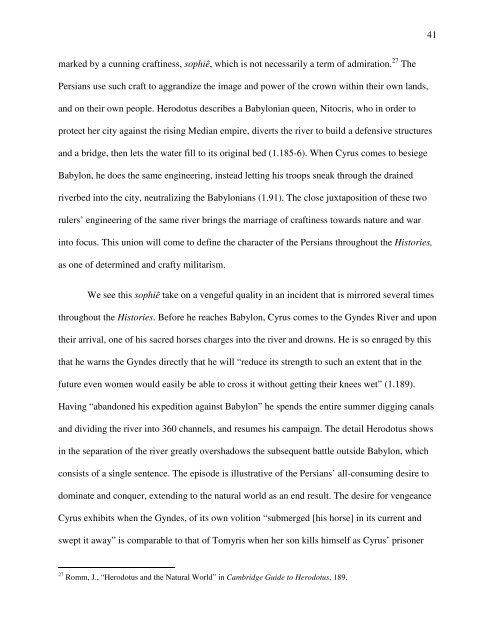The Old and the Restless - The Egyptians and the Scythians in Herodotus' Histories by Robert J. Hagan
You also want an ePaper? Increase the reach of your titles
YUMPU automatically turns print PDFs into web optimized ePapers that Google loves.
41<br />
marked <strong>by</strong> a cunn<strong>in</strong>g craft<strong>in</strong>ess, sophiê, which is not necessarily a term of admiration. 27 <strong>The</strong><br />
Persians use such craft to aggr<strong>and</strong>ize <strong>the</strong> image <strong>and</strong> power of <strong>the</strong> crown with<strong>in</strong> <strong>the</strong>ir own l<strong>and</strong>s,<br />
<strong>and</strong> on <strong>the</strong>ir own people. Herodotus describes a Ba<strong>by</strong>lonian queen, Nitocris, who <strong>in</strong> order to<br />
protect her city aga<strong>in</strong>st <strong>the</strong> ris<strong>in</strong>g Median empire, diverts <strong>the</strong> river to build a defensive structures<br />
<strong>and</strong> a bridge, <strong>the</strong>n lets <strong>the</strong> water fill to its orig<strong>in</strong>al bed (1.185-6). When Cyrus comes to besiege<br />
Ba<strong>by</strong>lon, he does <strong>the</strong> same eng<strong>in</strong>eer<strong>in</strong>g, <strong>in</strong>stead lett<strong>in</strong>g his troops sneak through <strong>the</strong> dra<strong>in</strong>ed<br />
riverbed <strong>in</strong>to <strong>the</strong> city, neutraliz<strong>in</strong>g <strong>the</strong> Ba<strong>by</strong>lonians (1.91). <strong>The</strong> close juxtaposition of <strong>the</strong>se two<br />
rulers’ eng<strong>in</strong>eer<strong>in</strong>g of <strong>the</strong> same river br<strong>in</strong>gs <strong>the</strong> marriage of craft<strong>in</strong>ess towards nature <strong>and</strong> war<br />
<strong>in</strong>to focus. This union will come to def<strong>in</strong>e <strong>the</strong> character of <strong>the</strong> Persians throughout <strong>the</strong> <strong>Histories</strong>,<br />
as one of determ<strong>in</strong>ed <strong>and</strong> crafty militarism.<br />
We see this sophiê take on a vengeful quality <strong>in</strong> an <strong>in</strong>cident that is mirrored several times<br />
throughout <strong>the</strong> <strong>Histories</strong>. Before he reaches Ba<strong>by</strong>lon, Cyrus comes to <strong>the</strong> Gyndes River <strong>and</strong> upon<br />
<strong>the</strong>ir arrival, one of his sacred horses charges <strong>in</strong>to <strong>the</strong> river <strong>and</strong> drowns. He is so enraged <strong>by</strong> this<br />
that he warns <strong>the</strong> Gyndes directly that he will “reduce its strength to such an extent that <strong>in</strong> <strong>the</strong><br />
future even women would easily be able to cross it without gett<strong>in</strong>g <strong>the</strong>ir knees wet” (1.189).<br />
Hav<strong>in</strong>g “ab<strong>and</strong>oned his expedition aga<strong>in</strong>st Ba<strong>by</strong>lon” he spends <strong>the</strong> entire summer digg<strong>in</strong>g canals<br />
<strong>and</strong> divid<strong>in</strong>g <strong>the</strong> river <strong>in</strong>to 360 channels, <strong>and</strong> resumes his campaign. <strong>The</strong> detail Herodotus shows<br />
<strong>in</strong> <strong>the</strong> separation of <strong>the</strong> river greatly overshadows <strong>the</strong> subsequent battle outside Ba<strong>by</strong>lon, which<br />
consists of a s<strong>in</strong>gle sentence. <strong>The</strong> episode is illustrative of <strong>the</strong> Persians’ all-consum<strong>in</strong>g desire to<br />
dom<strong>in</strong>ate <strong>and</strong> conquer, extend<strong>in</strong>g to <strong>the</strong> natural world as an end result. <strong>The</strong> desire for vengeance<br />
Cyrus exhibits when <strong>the</strong> Gyndes, of its own volition “submerged [his horse] <strong>in</strong> its current <strong>and</strong><br />
swept it away” is comparable to that of Tomyris when her son kills himself as Cyrus’ prisoner<br />
27 Romm, J., “Herodotus <strong>and</strong> <strong>the</strong> Natural World” <strong>in</strong> Cambridge Guide to Herodotus, 189.
















